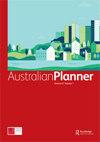Population growth and development: an outcome of Sydney's metropolitan governance
IF 1.2
Q2 Social Sciences
引用次数: 4
Abstract
ABSTRACT The central argument of the article is that Sydney's rapid population growth drives key decisions at national and state government levels, particularly decisions that support the development industry. At the national level, population growth is largely set by the Australian government through immigration levels, with Treasury support because it generates taxation revenue. The infrastructure costs of population growth are largely borne by the state government without adequate national government funding, but the state government supports population growth because it creates jobs and is regarded as a key marker of successful government. Under prevailing neoliberal ideology, private sector financing of necessary infrastructure is emphasised. This results in an increasing reliance on developer contributions, and on private sector funding where user-pays revenue is available, such as with motorways. In turn, Sydney's forecast population increase means the state government attempts to facilitate dwelling construction as much as possible. This is done through restricting otherwise desirable developer obligations outside state infrastructure contributions, reducing development controls, and restricting community opposition to new development.人口增长与发展:悉尼都市治理的结果
本文的中心论点是,悉尼的快速人口增长推动了国家和州政府层面的关键决策,特别是支持发展行业的决策。在全国范围内,人口增长主要是由澳大利亚政府通过移民水平设定的,财政部支持人口增长,因为它能带来税收收入。人口增长的基础设施成本主要由州政府承担,没有足够的国家政府资金,但州政府支持人口增长,因为它创造了就业机会,被视为政府成功的关键标志。在盛行的新自由主义意识形态下,私人部门对必要基础设施的融资受到重视。这导致越来越依赖开发商的贡献,以及用户自付收入的私营部门资金,比如高速公路。反过来,悉尼预测的人口增长意味着州政府试图尽可能地促进住宅建设。这是通过限制开发商在国家基础设施贡献之外的其他期望义务,减少开发控制,以及限制社区对新开发的反对来实现的。
本文章由计算机程序翻译,如有差异,请以英文原文为准。
求助全文
约1分钟内获得全文
求助全文

 求助内容:
求助内容: 应助结果提醒方式:
应助结果提醒方式:


